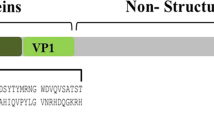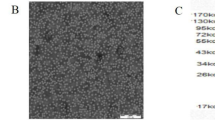Abstract
The present study was undertaken to clone and express the genes encoding antibody to the recombinant coat protein (rCP) of Papaya ringspot virus (PRSV) and to assess the engineered antibody for the detection of PRSV. A 33-kDa rCP of PRSV, which was produced in Escherichia coli, generated PRSV specific antibody in immunized mouse. The heavy and light chain variable domain genes (VH and VL) of 351 and 360 nucleotides, respectively, were cloned from the mRNA isolated from the spleen of the immunized mouse with rCP of PRSV. The VH and VL belong to the family IgG1 and kappa chain, respectively, and contained the framework regions and complementarity determining regions. The VH and VL genes were individually used to develop the expression constructs in pET28a (+) vector and 14-kDa proteins were obtained in E. coli. The amount of purified VH and VL proteins was 3–4 mg/l of bacterial culture. Both the antibody fragments recognized PRSV in the crude sap; however, the VL antibody fragment showed higher affinity to PRSV. The mixture of VH and VL detected PRSV as effectively as polyclonal antibody. The recombinant antibody fragments mixture detected PRSV in the field samples with 100 % accuracy in dot immunobinding assay (DIBA) and enzyme-linked immunosorbent assay (ELISA). The sensitivity of the detection of PRSV using antibody fragments was 1.0 and 10.0 ng in DIBA and ELISA, respectively. The results showed successful isolation of functional single-domain antibody encoding genes to PRSV directly from the immunized spleen cells of mouse. This study for the first time demonstrates application of bacterial expressed recombinant antibody fragments in immunodiagnosis of PRSV.






Similar content being viewed by others
References
Tripathi, S., Suzuki, J. Y., Ferreira, S. A., & Gonsalves, D. (2008). Papaya ringspot virus-P: Characteristics, pathogenicity, sequence variability and control. Molecular Plant Pathology, 9, 269–280.
Purcifull, D., Edwardson, J., Hiebert, E., & Gonsalves, D. (1984). Papaya ringspot virus. CMI/AAB Description of Plant Viruses, 8, 292.
Capoor, S. P., & Varma, P. M. (1958). A mosaic disease of papaya in Bombay. Indian. Journal of Agricultural Science, 29, 225–233.
Gonsalves, D., & Ishii, M. (1980). Purification and serology of Papaya ringspot virus. Phytopathology, 73, 1028–1032.
Rouis, S., Lafaye, P., Jaoua, L., Sghaier, Z., Ayadi, H., & Gargouri, R. (2006). Cloning and expression of functional single-chain Fv antibodies directed against NIa and coat proteins of potato virus Y. Journal of Virological Methods, 137, 1–6.
Rowhani, A. (1992). Use of Fab’2 antibody fragment in ELISA for the detection of grapevine viruses. American Journal of Enology and Viticulture, 43, 38–40.
Skerra, A., & Pluckthun, A. (1988). Assembly of a functional immunoglobulin Fv fragment in Escherichia coli. Science, 240, 1038–1041.
Bei, R., Schlom, J., & Kashmiri, S. V. (1995). Baculovirus expression of a functional single-chain immunoglobulin and its IL-2 fusion protein. Journal of Immunological Methods, 186, 245–255.
Davis, G. T., Bedzyk, W. D., Voss, E. W., & Jacobs, T. W. (1991). Single chain antibody SCA encoding genes: One-step construction and expression in eukaryotic cells. Biotechnology, 9, 165–169.
Conrad, U., & Fiedler, U. (1994). Expression of engineered antibodies in plant cells. Plant Molecular Biology, 26, 1023–1030.
Jost, C. R., Kurucz, I., Jacobus, C. M., Titus, J. A., George, A. J., & Segal, D. M. (1994). Mammalian expression and secretion of functional single-chain Fv molecules. Journal of Biological Chemistry, 269, 26267–26273.
Agarwal, S. M., Reddy, K., & Jain, R. K. (2009). Production of polyclonal antibodies using recombinant coat protein of Papaya ringspot virus and their use in immunodiagnosis. Journal of Plant Biochemistry and Biotechnology, 18, 109–111.
Kuan, C. P., Chen, K. H., & Su, H. J. (1999). Serological characterization of Papaya ringspot virus isolates in Taiwan. Botanical Bulletin of Academia Sinica, 40, 231–236.
Wang, Z., Raifu, M., Howard, M., Smith, L., Hansen, D., Goldsby, R., & Ratner, D. (2000). Universal PCR amplification of mouse immunoglobulin gene variable regions: The design of degenerate primers and an assessment of the effect of DNA polymerase 30 to 50 exonuclease activity. Journal of Immunological Methods, 233, 167–177.
Vijayanandraj, S., Yogita, M., Das, A., Ghosh, A., & Mandal, B. (2013). Highly efficient immunodiagnosis of Large cardamom chirke virus using the polyclonal antiserum against Escherichia coli expressed recombinant coat protein. Indian Journal of Virology, 24, 227–234.
Clark, M. F., & Bar-Joseph, M. (1984). Enzyme immunosorbent assays in plant virology. Methods in Virology, 7, 51–85.
Hawkins, R. E., & Winter, G. (1992). Cell selection strategies for making antibodies from variable gene libraries. European Journal of Immunology, 22, 867–870.
Kane, J. F. (1995). Effects of rare codon clusters on high-level expression of heterologous proteins in Escherichia coli. Current Opinion in Biotechnology, 6, 494–500.
Wang, L. H., Lee, H. C., & Hsu, T. H. (2004). Molecular cloning and sequencing of heavy and light chain cDNAs from Papaya ringspot and Cymbidium mosaic virus specific monoclonal antibodies. Plant Pathology Bulletin, 13, 7–16.
Hust, M., Maiss, E., Jacobsen, H. J., & Reinard, T. (2002). The production of a genus-specific recombinant antibody scFv using a recombinant potyvirus protease. Journal of Virological Methods, 106, 225–233.
Jahromi, Z. M., Salmanian, A. H., Rastgoo, N., & Arbabi, M. (2009). Isolation of BNYVV coat protein-specific single chain Fv from a mouse phage library antibody. Hybridoma, 28, 305–313.
Saldarelli, P., Keller, H. J. H. G., Dell’Orco, M., Schots, A., Elicio, V., & Minafra, A. (2005). Isolation of recombinant antibodies scFvs to grapevine virus B. Journal of Virological Methods, 124, 191–195.
Boonham, N., & Barker, I. (1998). Strain specific recombinant antibodies to potato virus Y potyvirus. Journal of Immunological Methods, 74, 193–199.
Franconi, R., Roggero, P., Pirazzi, P., Arias, F. J., Desiderio, A., Bitti, O., et al. (1999). Functional expression in bacteria and plants of a scFv antibody fragment against tospoviruses. Immunotechnology, 4, 189–201.
Ewert, S., Honegger, A., & Pluckthun, A. (2003). Structure-based improvement of the biophysical properties of immunoglobulin VH domains with a generalizable approach. Biochemistry, 42, 1517–1528.
Dudgeon, K., Famm, K., & Christ, D. (2008). Sequence determinants of protein aggregation in human VH domains. Protein Engineering, Design and Selection, pp. 1–4. doi:10.1093/protein/gzn059.
Baker, C. A., Lecoq, H., & Purcifull, D. E. (1991). Serological and biological variability among Papaya ringspot virus type-W isolates in Florida. Phytopathology, 81, 722–728.
Acknowledgments
Financial support from ICAR-World Bank funded National Agricultural Innovation project (NAIP Component-4) is thankfully acknowledged.
Author information
Authors and Affiliations
Corresponding author
Rights and permissions
About this article
Cite this article
Maheshwari, Y., Verma, H.N., Jain, R.K. et al. Engineered Antibody Fragments for Immunodiagnosis of Papaya ringspot virus. Mol Biotechnol 57, 644–652 (2015). https://doi.org/10.1007/s12033-015-9854-5
Published:
Issue Date:
DOI: https://doi.org/10.1007/s12033-015-9854-5




